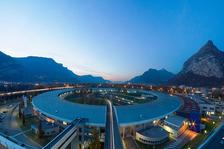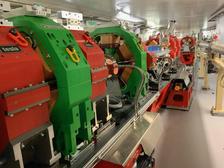Aerial view of the ESRF. (Credit: ESRF, Pierre Jayet)
A brilliant new light shines in Grenoble, France, with the opening of the European Synchrotron Radiation Facility's Extremely Brilliant Source (ESRF-EBS), the first-of-a-kind fourth-generation high-energy synchrotron. After a 20-month shutdown, scientific users are back at the ESRF to carry out experiments with the new EBS source. “This is a moment of pride for the whole of the synchrotron community,” says Francesco Sette, Director-General of the ESRF. “With the opening of this brand-new generation of high-energy synchrotron, the ESRF continues its pioneering role to provide an unprecedented new tool for scientists to push the frontiers of science and address vital challenges facing our society today, such as health, and the environment.”
The ring-shaped machine, 844 metres in circumference, generates X-ray beams 100 times brighter than its predecessor’s, and 10 trillion times brighter than medical X-rays. “The novel accelerator technology of the ESRF-EBS opens the door to revolutionary new insights into the molecular machinery of complex materials and biological systems. This is the new tool for the design of future technologies and better drugs and thus of highest relevance for the future of the European society,” says DESY's Director General, Helmut Dosch, who is also Vice-Chair of the ESRF Council. DESY is representing Germany at the ESRF with a share of 24 per cent.
A shining example of international cooperation, EBS has been funded by 22 countries joining forces to construct this innovative and world-unique research infrastructure with an investment of 150 million euros over 2015-2022, lighting the way for more than a dozen projects worldwide, including PETRA IV at DESY. “With its fantastic beam properties ESRF-EBS will take the lead in hard X-ray science and open a new window into nano science“ says Edgar Weckert, DESY's Director in charge of Photon Science and present Chair of ESRF's Scientific Advisory Committee.
“With the technology the ESRF has developed for the EBS upgrade, synchrotron radiation sources are transformed into giant microscopes, enabling spot-on studies of complex matter. With its large circumference, PETRA IV at DESY will be able to push this technology to the limits in the future and become the ultimate 3D X-ray microscope for biological, chemical, and physical processes,” says Christian Schroer, project leader for PETRA IV at DESY and member of the ESRF Council.
Meanwhile, the scientific community looks eagerly at the opportunities, ESRF's next generation light source has to offer. Among the first researchers to work at the ESRF-EBS is Henry Chapman, Lead Scientist at DESY and Professor of Physics at the University of Hamburg. “I am very much looking forward to the new era of X-ray science opened up by the coherent laser-like beams of the next generation light sources, and I can’t wait to explore our new ideas in holographic imaging to see details of the structure of dense objects that wasn’t possible before,” he emphasises.
Further reading: ESRF press release








